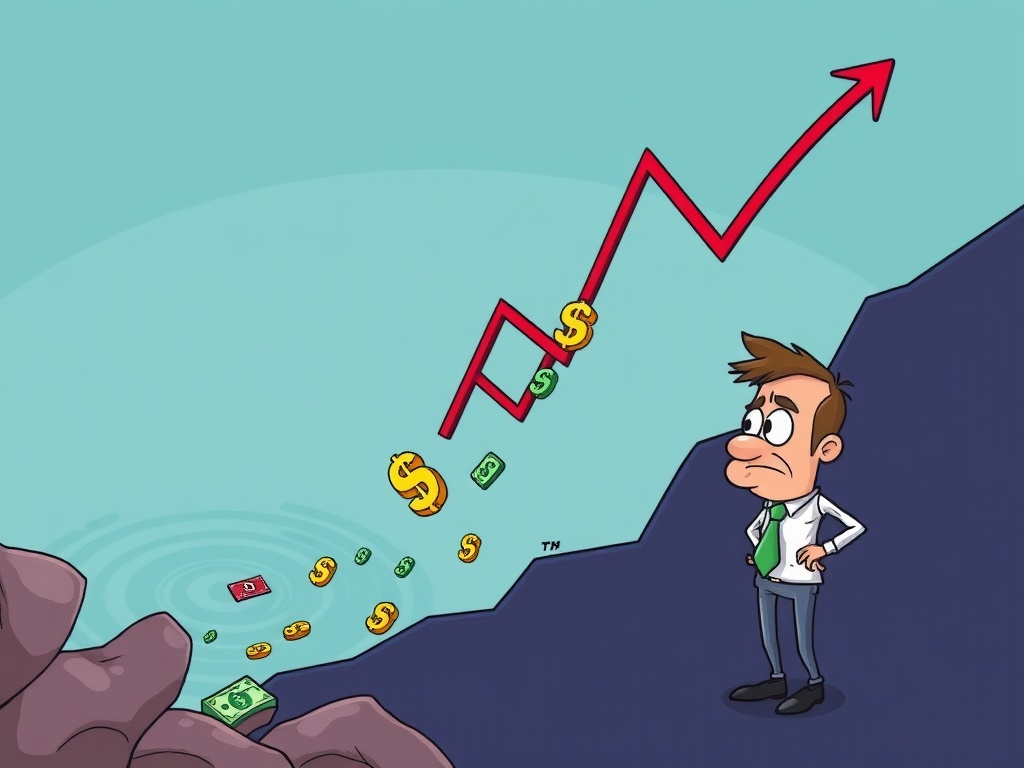BitcoinWorld

Market Volatility: Urgent Concerns as U.S. Stocks See Initial Dip
The financial world often operates like a complex ecosystem, where shifts in one area can create ripples across others. Recently, the opening bell on Wall Street signaled a notable dip for the three major U.S. stock markets, immediately sparking discussions about broader economic sentiment. For those closely watching the cryptocurrency space, such movements in traditional finance are rarely isolated events. This initial decline in U.S. stocks highlights a period of increasing Market volatility, a factor that can significantly influence investor behavior and capital flows, potentially affecting digital assets as well. Understanding these traditional market shifts is crucial for anyone navigating the dynamic landscape of both stocks and crypto.
What Does This Market Volatility Mean for You?
When the S&P 500, Nasdaq, and Dow Jones Industrial Average all open lower, it’s a signal that investors are reacting to current economic conditions or future expectations. This immediate reaction can be driven by a range of factors, from inflation data and interest rate hikes to geopolitical tensions or corporate earnings reports. The percentages, while seemingly small, represent billions of dollars in market capitalization and reflect a collective sentiment of caution or concern among institutional and retail investors alike. This kind of Market volatility often leads to a ‘risk-off’ environment, where investors tend to move away from assets perceived as higher risk.
Let’s look at the initial figures that marked this recent opening:
| Market Index | Opening Performance |
|---|---|
| S&P 500 | -0.98% |
| Nasdaq | -0.99% |
| Dow Jones Industrial Average | -0.79% |
These figures indicate a broad-based decline, affecting a wide spectrum of companies, from established industrial giants to fast-growing technology firms. For individual investors, this means that portfolios tied to these indices might see immediate value reductions. The challenge here is to not panic, but to understand the underlying reasons for such Market volatility and consider long-term strategies rather than short-term reactions.
How Does Market Volatility Impact Cryptocurrency?
The relationship between traditional stock markets and the cryptocurrency market has evolved significantly. While once seen as largely uncorrelated, a trend towards increased correlation has become more evident, especially during periods of heightened Market volatility. When traditional markets experience a downturn, it can often lead to a ripple effect in the crypto space for several reasons:
- Investor Sentiment: A general ‘risk-off’ mood in traditional markets can spill over into cryptocurrencies, as investors become more cautious about all forms of risk assets.
- Liquidity Crunch: In times of financial stress, investors might sell off crypto assets to cover losses in traditional portfolios or to meet margin calls, leading to downward price pressure.
- Macroeconomic Factors: Shared drivers like inflation, interest rate hikes by central banks, and global economic slowdowns affect both markets. For instance, higher interest rates make safer investments like bonds more attractive, potentially drawing capital away from speculative assets like crypto.
Historically, Bitcoin, often considered the bellwether for the crypto market, has shown periods of both correlation and decoupling from the S&P 500. However, in recent years, particularly during significant economic shifts, the correlation has strengthened. This suggests that the crypto market, while still having its unique drivers, is increasingly susceptible to the same macroeconomic forces that influence traditional stocks. Therefore, an initial dip in U.S. stocks, while not a direct cause for crypto collapse, is a strong indicator for crypto investors to monitor the situation closely and assess potential impacts on their digital asset holdings amidst ongoing Market volatility.
Are There Opportunities Amidst Market Volatility?
While a downturn can feel unsettling, periods of Market volatility can also present unique opportunities for informed investors. For those with a long-term perspective, dips can be seen as chances to acquire assets at a lower price. This strategy is often referred to as ‘buying the dip’ or dollar-cost averaging.
Consider these potential opportunities:
- Dollar-Cost Averaging: Instead of trying to time the market, investing a fixed amount regularly, regardless of price, can help reduce the average cost of your investments over time. During a dip, each investment buys more units.
- Identifying Strong Fundamentals: A market downturn can help distinguish projects or companies with strong fundamentals and genuine utility from those that were overvalued. Focus on assets with solid technology, active development, and clear use cases.
- Diversification Reassessment: This is a good time to review your portfolio’s diversification. Are you overexposed to certain sectors or asset classes? Adjusting your portfolio can help mitigate risks associated with specific market segments.
- Research and Education: Use this period to deepen your understanding of the markets. The more you know about the factors driving Market volatility, the better equipped you’ll be to make informed decisions.
It’s important to approach these opportunities with caution and a clear strategy, avoiding emotional decisions. Not every dip is an opportunity, and thorough research remains paramount.
Navigating Market Volatility: Actionable Insights
Dealing with Market volatility requires a disciplined approach and a clear understanding of your personal financial goals and risk tolerance. Here are some actionable insights to help you navigate these turbulent times:
- Stay Informed, Not Overwhelmed: Keep an eye on credible financial news sources, but avoid constant checking that can lead to emotional decisions. Focus on understanding the bigger picture rather than day-to-day fluctuations.
- Review Your Investment Thesis: Revisit why you invested in certain assets. Have the underlying fundamentals changed? If your original reasons for investing are still valid, a temporary dip might not warrant a change in strategy.
- Manage Your Risk: Ensure your portfolio is aligned with your risk tolerance. This might involve setting stop-loss orders for some assets, or simply having a clear exit strategy for parts of your portfolio if certain conditions are met. Never invest more than you can afford to lose.
- Maintain a Long-Term Perspective: Markets have historically recovered from downturns. While past performance is not indicative of future results, a long-term mindset can help you ride out short-term fluctuations and avoid selling assets at a loss.
- Consult with Professionals: If you’re unsure about how to proceed, consider speaking with a financial advisor. They can provide personalized guidance based on your specific situation and help you develop a robust strategy for managing Market volatility.
Remember, patience and discipline are your greatest allies during periods of economic uncertainty. By adopting a proactive and informed approach, you can better position yourself to weather the storms and potentially capitalize on future opportunities.
The initial dip in major U.S. stock markets serves as a timely reminder of the inherent Market volatility that defines financial landscapes. While the immediate reaction might be concern, it also underscores the interconnectedness of global markets, including the burgeoning cryptocurrency sector. Understanding these dynamics, from the reasons behind stock market movements to their potential ripple effects on digital assets, is vital for every investor. By staying informed, managing risk effectively, and maintaining a long-term perspective, individuals can navigate these shifts with greater confidence. Ultimately, periods of uncertainty are also periods of learning and strategic adjustment, paving the way for more resilient investment approaches in the future.
Frequently Asked Questions (FAQs)
Q1: What is Market volatility?
A: Market volatility refers to the rate at which the price of a security or market index increases or decreases over a given period. High volatility means prices can change dramatically and unpredictably, while low volatility means prices are relatively stable. It’s often measured by the standard deviation of price changes.
Q2: How quickly do stock markets typically recover from a dip?
A: Recovery times vary significantly depending on the cause and severity of the dip. Minor dips, like the recent one, might recover quickly within days or weeks. Larger downturns, driven by significant economic events, can take months or even years. Historical data suggests markets tend to recover over the long term, but there’s no guaranteed timeline.
Q3: Should I sell my investments when the market is volatile?
A: Generally, selling investments during a period of Market volatility, especially when prices are down, is not recommended as it locks in losses. Unless your financial situation has drastically changed or your investment thesis is no longer valid, it’s often better to hold or even consider dollar-cost averaging during dips, provided you have a long-term strategy.
Q4: Is cryptocurrency a good hedge against stock market volatility?
A: The role of cryptocurrency as a hedge against traditional market volatility is debated. While some proponents argue Bitcoin acts as ‘digital gold’ and a safe haven, recent trends show increased correlation with stock markets, particularly during significant economic events. Its effectiveness as a hedge depends on various factors and can change over time.
Q5: What are some common causes of Market volatility?
A: Common causes include economic data releases (inflation, unemployment), central bank policy decisions (interest rates), geopolitical events (wars, trade disputes), corporate earnings reports, technological advancements, and shifts in investor sentiment or confidence.
Did you find this article helpful in understanding the recent market movements and their implications? Share this article on your social media to help others stay informed about Market volatility and its impact on financial markets!
To learn more about the latest crypto market trends, explore our article on key developments shaping Bitcoin institutional adoption.
This post Market Volatility: Urgent Concerns as U.S. Stocks See Initial Dip first appeared on BitcoinWorld and is written by Editorial Team





